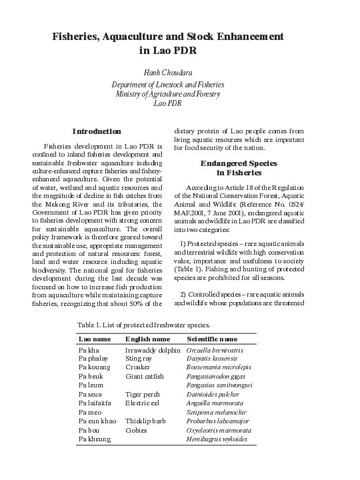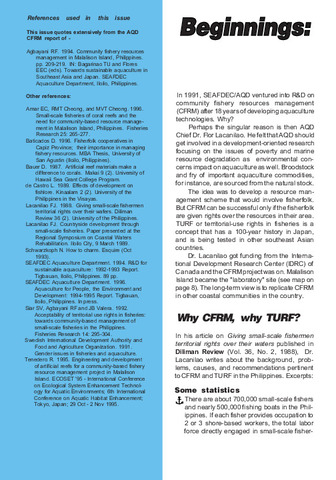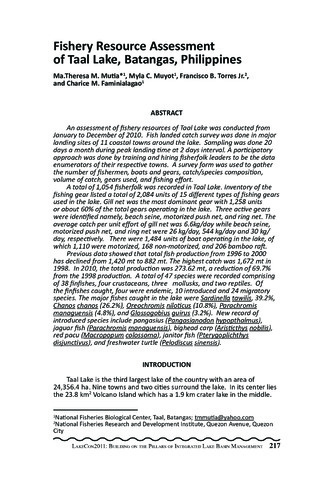Perlihatkan publikasi sederhana
Fisheries in the floodplain lakes of Agusan marsh and its implications for sound management
| dc.contributor.author | Talde, Cheryl M. | |
| dc.contributor.author | Mamaril, Sr., Augustus C. | |
| dc.contributor.author | Palomares, Ma. Lourdes D. | |
| dc.contributor.editor | Cuvin-Aralar, Maria Lourdes | |
| dc.contributor.editor | Punongbayan, Raymundo S. | |
| dc.contributor.editor | Santos-Borja, Adelina | |
| dc.contributor.editor | Castillo, Lourdes V. | |
| dc.contributor.editor | Manalili, Eduardo V. | |
| dc.contributor.editor | Mendoza, Marlynn M. | |
| dc.date.accessioned | 2021-07-27T06:07:34Z | |
| dc.date.available | 2021-07-27T06:07:34Z | |
| dc.date.issued | 2005 | |
| dc.identifier.citation | Talde, C. M., Mamaril, Sr., A. C., & Palomares, Ma. L. D. (2005). Fisheries in the floodplain lakes of Agusan marsh and its implications for sound management. In M. L. Cuvin-Aralar, R. S. Punongbayan, A. Santos-Borja, L. V. Castillo, E. V. Manalili, & M. M. Mendoza (Eds.), Proceedings of the First National Congress on Philippine Lakes (pp. 129-133). Southeast Asian Regional Center for Graduate Study and Research in Agriculture (SEARCA). | en |
| dc.identifier.issn | 1656-8099 | |
| dc.identifier.uri | http://hdl.handle.net/10862/6130 | |
| dc.description.abstract | Yearlong assessment of the artisanal fishery from the three floodplain lakes of Ticgon, Dinagat, and Mihaba in Agusan Marsh, a declared national priority protected area, was done using length-weight frequency analyses. Results showed that the catch on economically-important fishes such as Cyprinus carpio and Trichogaster pectoralis in Lakes Ticgon and Mihaba did not suggest growth overfishing. The regulated mesh size allowed in the area is, to some extent, effective. However, Oreochromis niloticus and Trichogaster pectoralis caught from Lake Dinagat were found to have sizes below the optimum and with size less than its length at first maturity. This assessment has a very profound implication to the conservation efforts in the area considering that fishery in the marsh is a cheap source of protein for the local communities. Yet, the continuity of the said regulations remains a formidable challenge for some reasons: community in the marsh is dispersed; the area is so vast with lots of entry and exit points making monitoring a tedious and expensive job; and unabated electrofishing, although declared an illegal activity, is still more profitable than mere use of fishing gears. | en |
| dc.language.iso | en | en |
| dc.publisher | Southeast Asian Regional Center for Graduate Study and Research in Agriculture (SEARCA) | en |
| dc.subject | Cyprinus carpio | en |
| dc.subject | Oreochromis niloticus | en |
| dc.subject | Trichogaster pectoralis | en |
| dc.title | Fisheries in the floodplain lakes of Agusan marsh and its implications for sound management | en |
| dc.type | Conference paper | en |
| dc.citation.spage | 129 | en |
| dc.citation.epage | 133 | en |
| dc.citation.conferenceTitle | Proceedings of the First National Congress on Philippine Lakes | en |
| dc.subject.asfa | fisheries | en |
| dc.subject.asfa | flood plains | en |
| dc.subject.asfa | lakes | en |
| dc.subject.asfa | wetlands | en |
| dc.subject.asfa | fishery resources | en |
| dc.subject.asfa | fishery management | en |
| dc.subject.asfa | gillnets | en |
| dc.subject.asfa | mesh regulations | en |
Files in this item
| Files | Size | Format | View |
|---|---|---|---|
|
There are no files associated with this item. |
|||
Publikasi ini ada di koleksi berikut
-
LakeCon2003 [49]
Proceedings of the First National Congress on Philippine Lakes



